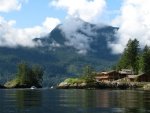Pat:
Wow!!! You must be really heavy. Not surprising if you were equipped and provisioned for the loop. Best I could tell by reading your blog is that you got up to 20 mph against a 2.5 mph current at wot with your current prop.
That isn't even close to what I would have expected. At a 5,000 lb total weight you should be able to do ten mph more. I have to push your weight up way beyond reasonableness to get the kind of numbers you are talking about.
At your very slow average speed of 6.4 kts the power required is trivial, about 10 hp. That engine should last forever at that load.
I realize that Wefings should be the pros at figuring out the right prop, but something is wrong. Your current hull/prop is extremely inefficient to require 150 hp to go 20 mph even at a loaded weight of 6,000 lbs. Maybe you are so heavily loaded that the boat acts more like a displacement hull than a planing hull.
And don't go back to your original prop or the 13" prop you mentioned in your blog. Even at low speeds the engine will appreciate running at a little more rpm which reduces stress on it.
Thanks for the data.
David
Wow!!! You must be really heavy. Not surprising if you were equipped and provisioned for the loop. Best I could tell by reading your blog is that you got up to 20 mph against a 2.5 mph current at wot with your current prop.
That isn't even close to what I would have expected. At a 5,000 lb total weight you should be able to do ten mph more. I have to push your weight up way beyond reasonableness to get the kind of numbers you are talking about.
At your very slow average speed of 6.4 kts the power required is trivial, about 10 hp. That engine should last forever at that load.
I realize that Wefings should be the pros at figuring out the right prop, but something is wrong. Your current hull/prop is extremely inefficient to require 150 hp to go 20 mph even at a loaded weight of 6,000 lbs. Maybe you are so heavily loaded that the boat acts more like a displacement hull than a planing hull.
And don't go back to your original prop or the 13" prop you mentioned in your blog. Even at low speeds the engine will appreciate running at a little more rpm which reduces stress on it.
Thanks for the data.
David

